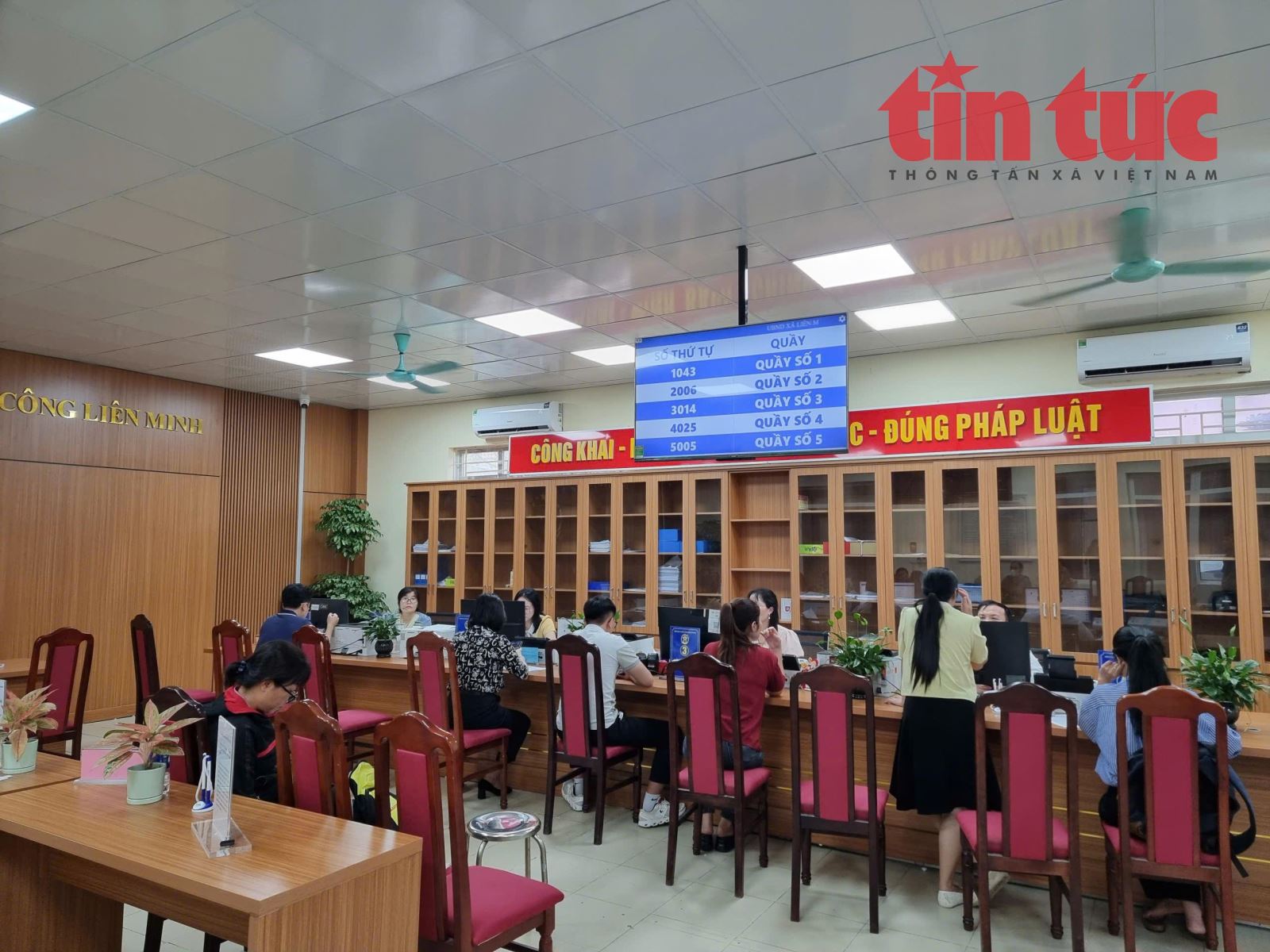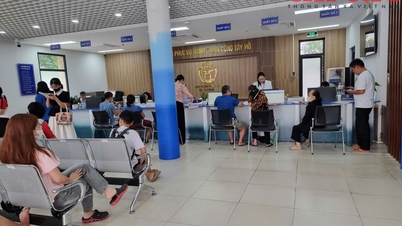Data connection problem
Sharing about the solution in handling public administrative procedures online, Mr. Ho Duc Thang, Director of the National Institute of Digital Technology and Digital Transformation ( Ministry of Science and Technology ) said: After about 4 months of operation, the problems in software application are being gradually overcome and improved by technology units together with the two-level government. However, the most difficult problem now is the problem of connecting and communicating data between ministries, branches, units and reusing existing data to reduce existing processes, optimize work for civil servants, but still ensure compliance with regulations, reduce inconvenience for people.

Specifically, the representative of the National Digital Transformation Agency said: In the process of implementing administrative procedures and online public services according to the two-level local government model, the Ministry of Science and Technology (MOST) has compiled 28 existing problems, of which 22 have been resolved, while 6 are long-term issues that need to focus resources to thoroughly overcome. The main problems are related to optimizing interactive electronic forms (eForms), simplifying profile components, ensuring facilities for disadvantaged communes, overcoming signal dips, effectively exploiting old and new electronic data warehouses, as well as connecting and exploiting data from national databases and systems of ministries and branches.
According to local reports, data connection between ministries and branches in handling online public services still has some bottlenecks, not ensuring smooth and effective implementation, and not substantially reducing time and costs of administrative procedure compliance.
Specifically: The Ministry of Finance is having 4 connection issues, including: Integrating and providing online payment services for financial obligations (taxes, registration fees) in performing administrative procedures on land for households, individuals, and enterprises; connecting the National Database on Business Registration with the provincial administrative procedure settlement information system (TTTT GQ TTHC); connecting the provincial TTHC GQ HTTT with the code granting system for budget-related units; errors frequently arising on the National Single Window Portal.
The Ministry of Health still has one issue regarding upgrading the National Management System on registration and licensing of medical examination and treatment and completing the connection with the national database by December 2025.
The Ministry of Justice still has one problem with the electronic civil status registration and management system; some provinces and cities still report slow and faulty systems (An Giang, Bac Ninh, Can Tho City, Dong Nai).
The Ministry of Home Affairs still has a problem connecting the provincial-level administrative procedure processing system with the database of beneficiaries of preferential policies for meritorious people. The Ministry of Science and Technology has coordinated, verified the cause and recorded that there are no technical problems. The Ministry of Home Affairs is researching and resolving this.
The Ministry of Public Security still has two issues related to the connection between the provincial-level administrative procedure processing system and the inter-connected public service software to carry out two groups of electronic inter-connected administrative procedures in accordance with the provisions of Decree No. 63/2024/ND-CP. The Ministry of Public Security has proposed a solution to overcome these issues.
The Ministry of Natural Resources and Environment has a problem connecting to the land database. Up to now, 33/34 provinces and cities have completed the connection when performing administrative procedures on land, the remaining one is Hanoi City. The Ministry of Natural Resources and Environment needs to coordinate with Hanoi to complete it.
According to the National Digital Transformation Agency, up to now, ministries, branches and localities have actively deployed measures to overcome bottlenecks in the implementation process. However, 10/20 connection issues continue to be bottlenecks, affecting the implementation of administrative procedures and the provision of online public services under the two-tier local government model. The National Digital Transformation Agency said it will continue to coordinate with relevant units to completely remove them, ensuring synchronization and real effectiveness in the implementation of online public services throughout the process.
Data cleaning
From the perspective of a technology expert, Mr. Tran Huy Tung, Director of the Research and Development Center, ELCOM Corporation said: In the past, we have coordinated with many departments and branches in localities in data processing. When delving into each group of data, we can see the chaotic situation, lack of standardization and not following any rules. This leads to the fact that although many data centers have been organized and high-tech applications have been deployed to exploit data, after processing, those centers still find it difficult to operate effectively because the input data is not synchronized, not standardized, so it is difficult to exploit.

When the connection system between parties is not consistent, data from one unit cannot be used by another. This is a big problem that needs to be focused on in the coming time; otherwise, the deployment of artificial intelligence models will not be able to effectively promote the effectiveness of the current non-standard data source.
Mr. Tran Huy Tung shared: “I myself have accessed the Public Service Portal to do administrative procedures online and found it difficult to do without guidance. Currently, the Portal is in the 'computerization' stage, which means transferring the paper process to the digital environment, but the destination must be 'full process', which means redesigning the entire process so that people and businesses can use it conveniently.” Instead of just digitizing the old process, it is necessary to change the approach, focusing on users, and seeing what benefits they can get from that service.
When integrating artificial intelligence (AI) into the process, this technology does not only play the role of a chatbot to answer questions, but can also help shorten the entire process, even to just a few steps. To do that, it is necessary to change the mindset from the application design stage, towards friendliness, convenience and experience, similar to the e-commerce services that people are familiar with.
Reality over the past 4 months has shown that the implementation of the two-level government model has significantly increased the workload of grassroots officials; on average, a commune or ward has to serve about 30,000 people. Building a digital government is like building a house with 3 pillars: People - Data - Technology. In which, people are the most important factor, from the commitment of leaders to the participation of implementing officials; data needs to be standardized, shared and interconnected during operation; technology applications include digital infrastructure and AI applications.
"To apply AI, it is important to build standardized data. Currently, units are implementing according to the motto "Correct - Sufficient - Clean - Living". On that basis, AI engine (artificial intelligence core) and security solutions will support leaders in making decisions, support staff in handling work and guide people to perform online administrative procedures more effectively", Mr. Tran Huy Tung shared.
Source: https://baotintuc.vn/xa-hoi/giai-quyet-thu-tuc-hanh-chinh-truc-tuyen-bai-cuoi-van-con-vuong-mac-ket-noi-du-lieu-giua-cac-bo-nganh-20251111152718249.htm



![[Photo] Prime Minister Pham Minh Chinh attends a conference to review one year of deploying forces to participate in protecting security and order at the grassroots level.](https://vphoto.vietnam.vn/thumb/1200x675/vietnam/resource/IMAGE/2025/11/12/1762957553775_dsc-2379-jpg.webp)
![[Photo] Highways passing through Dong Nai](https://vphoto.vietnam.vn/thumb/1200x675/vietnam/resource/IMAGE/2025/11/12/1762940149627_ndo_br_1-resize-5756-jpg.webp)






























































































![Dong Nai OCOP transition: [Article 3] Linking tourism with OCOP product consumption](https://vphoto.vietnam.vn/thumb/402x226/vietnam/resource/IMAGE/2025/11/10/1762739199309_1324-2740-7_n-162543_981.jpeg)







Comment (0)